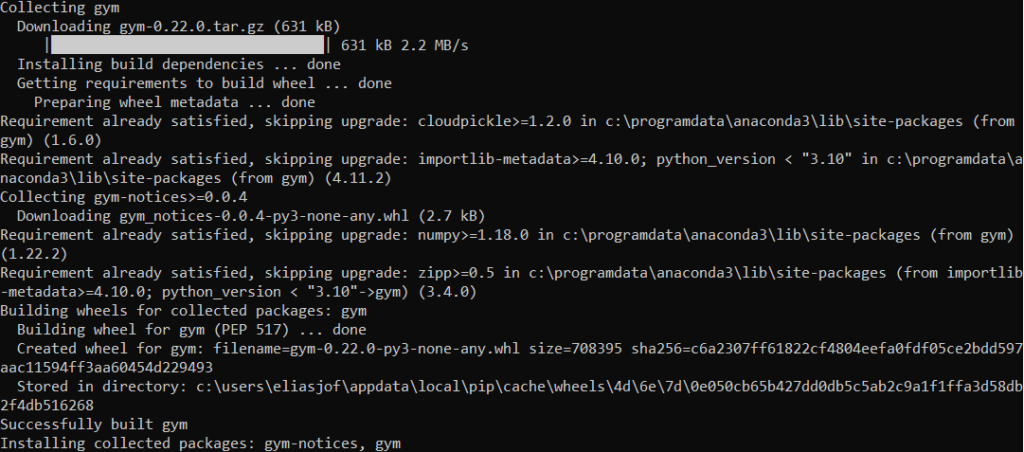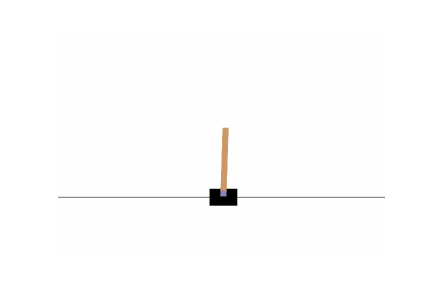Vamos utilizar a plataforma OpenAI Gym para treinar e testar um sistema de controle baseado em Aprendizado por Reforço.
Instalação
Se estiver utilizando no Windows, abra o prompt do Anaconda (administrador) e digite:
pip install --upgrade gym
# No windows
pip install pygame --upgrade
# No linux
sudo apt-get install python3-pygame
# para salvar os vídeos das simulações:
#.mp4
conda install -c conda-forge ffmpeg

Utilização básica
Algumas possibilidades de simulações disponibilizadas pela plataforma Gym, mais detalhes em: https://gym.openai.com/
import gym
gym.envs.registry.all()

Importações
# Python ≥3.5 is required
import sys
assert sys.version_info >= (3, 5)
# Scikit-Learn ≥0.20 is required
import sklearn
assert sklearn.__version__ >= "0.20"
# TensorFlow ≥2.0 is required
import tensorflow as tf
from tensorflow import keras
assert tf.__version__ >= "2.0"
if not tf.config.list_physical_devices('GPU'):
print("No GPU was detected. CNNs can be very slow without a GPU.")
if IS_COLAB:
print("Go to Runtime > Change runtime and select a GPU hardware accelerator.")
if IS_KAGGLE:
print("Go to Settings > Accelerator and select GPU.")
# Common imports
import numpy as np
import os
# to make this notebook's output stable across runs
np.random.seed(42)
tf.random.set_seed(42)
# To plot pretty figures
%matplotlib inline
import matplotlib as mpl
import matplotlib.pyplot as plt
mpl.rc('axes', labelsize=14)
mpl.rc('xtick', labelsize=12)
mpl.rc('ytick', labelsize=12)
# To get smooth animations
import matplotlib.animation as animation
mpl.rc('animation', html='jshtml')
from matplotlib.animation import PillowWriter
Funções para visualizar e salvar (animações e figuras)
def update_scene(num, frames, patch):
patch.set_data(frames[num])
return patch,
def plot_animation(frames, repeat=False, interval=40):
fig = plt.figure()
patch = plt.imshow(frames[0])
plt.axis('off')
anim = animation.FuncAnimation(
fig, update_scene, fargs=(frames, patch),
frames=len(frames), repeat=repeat, interval=interval)
plt.close()
return anim
def save_animation(anime, type='mp4', fps=1,path='videos/', name=None):
if type in 'mp4':
writer = animation.writers['ffmpeg']
writer = writer(fps=fps, metadata=dict(artist='Me'), bitrate=1800)
anime.save(path + name +'.mp4', writer=writer)
elif type in 'gif':
writer = PillowWriter(fps=fps)
anime.save(path + name +'.gif', writer=writer)
TEST_ID = "rl"
IMAGES_PATH = os.path.join(PROJECT_ROOT_DIR, "images", TEST_ID )
os.makedirs(IMAGES_PATH, exist_ok=True)
def save_fig(fig_id, tight_layout=True, fig_extension="png", resolution=300):
path = os.path.join(IMAGES_PATH, fig_id + "." + fig_extension)
print("Saving figure", fig_id)
if tight_layout:
plt.tight_layout()
plt.savefig(path, format=fig_extension, dpi=resolution)
def plot_environment(env, figsize=(5,4)):
plt.figure(figsize=figsize)
img = env.render(mode="rgb_array")
plt.imshow(img)
plt.axis("off")
return imgObs.: No windows instale a seguinte biblioteca:
conda install -c conda-forge ffmpeg
Rodando um exemplo simples
Utilizamos nesse exemplo o problema Cart-pole (um carrinho com uma haste que deve se movimentar para manter a haste na vertical, a cada intervalo que a haste não caiu no chão, é fornecido pelo jogo uma recompensa de 1 ponto). Para garantir o sucesso ao longo de 200 intervalos, definimos uma política (algoritmo que o agente utiliza para maximizar as recompensas) para o agente: se o ângulo da haste é positiva, o carrinho deve deslocar para a direita (1), caso contrário, desloque para esquerda (0).
env = gym.make('CartPole-v1')
env.seed(42)
def basic_policy(obs):
angle = obs[2]
return 0 if angle < 0 else 1
totals = []
for episode in range(500):
episode_rewards = 0
obs = env.reset()
for step in range(200):
action = basic_policy(obs)
obs, reward, done, info = env.step(action)
episode_rewards += reward
if done:
break
totals.append(episode_rewards)
anime = plot_animation(frames)
save_animation(anime, type='gif', fps = 30, name="Cartpole-v1-p1")
anime
Resultado da política simples: 78/200 intervalos sem deixar a haste cair